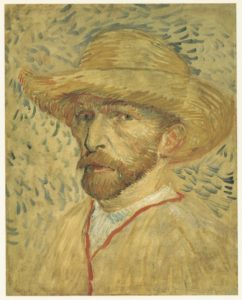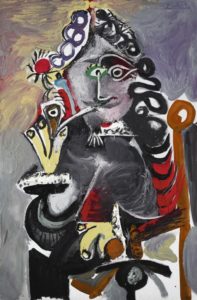In 1968 Picasso executed a series of large canvases depicting sword-brandishing musketeers. One of the great subjects of the artist’s late oeuvre, the musketeer was one of the various archetypes that populated his paintings. In choosing the iconography shared by Old Master painters such as Rembrandt and Velázquez, Picasso was, at the end of his career, consciously aligning himself with the greatest artists of the Western canon.
The Golden Age of Painting
As a theme, the musketeer allowed Picasso to escape the limitations of contemporary subject matter and explore the spirit of a past age. These chara cters embodied the courtly mannerisms of the Renaissance gentleman and signified the golden age of painting, reflecting the influence of Velázquez, Rembrandt and Rubens on Picasso’s art. Picasso had devoted a large portion of his time and passion throughout the 1960s to the reinterpretation and investigation of the Old Masters, an experience in which he reaffirmed his connection to some of the greatest painters in the history of art.
cters embodied the courtly mannerisms of the Renaissance gentleman and signified the golden age of painting, reflecting the influence of Velázquez, Rembrandt and Rubens on Picasso’s art. Picasso had devoted a large portion of his time and passion throughout the 1960s to the reinterpretation and investigation of the Old Masters, an experience in which he reaffirmed his connection to some of the greatest painters in the history of art.
The musketeer series was a continuation of this interest and began, according to his wife Jacqueline Roque, ‘when Picasso started to study Rembrandt,’ but his appreciation of other great figures of the Renaissance, including Shakespeare, also influenced the appearance of these characters. This occurred at a time when Picasso rarely left his country house outside Mougins, preferring to immerse himself in the masterpieces of art history. He was focused on a reinterpretation of the old masters, a practice that reaffirmed his connection to history’s greatest painters.
Picasso’s Musketeer as Self Portrait
In 1966, a new and final character emerged in Picasso’s iconography and dominated his last period to the point of becoming its emblem. This was the Golden Age gentleman, a half-Spanish, half-Dutch musketeer dressed in richly adorned clothing.
“In 1966, a new and final character emerged in Picasso’s iconography and dominated his last period to the point of becoming its emblem. This was the Golden Age gentleman, a half-Spanish, half-Dutch musketeer dressed in richly adorned clothing. […] all of these musketeers are men in disguise, romantic gentlemen, virile and arrogant soldiers, vainglorious and ridiculous despite their haughtiness.”

Picasso’s work on this theme began in the mid-1960s with a series of engravings and works on paper, and later a variety of canvases of the musketeer. As Picasso developed this series during the late 1960s and into the 1970s, the musketeer became a multi-dimensional figure, exhibiting a range of personalities including card players, musicians and pipe smokers, illustrating the artist’s own adventures as a bon vivant.
The musketeers are understood to be disguised portraits of Picasso himself. As Marie-Laure Bernadac observed: “If woman was depicted in all her aspects in Picasso’s art, man always appeared in disguise or in a specific role, the painter at work or the musketeer-matador holding the implements of his virility – the long pipe, the dagger, or the sword.”
Van Gogh: Patron Saint
“Of all the artists with whom Picasso identified, Van Gogh is the least often cited but probably the one that meant the most to him in later years.

He talked of him as his patron saint, talked of him with intense admiration and compassion, never with any of his habitual irony or mockery. Van Gogh, like Cézanne earlier in Picasso’s life, was sacrosanct.”
In some instances, Picasso’s musketeer would don a yellow hat, its significance tied to another focus of the artist. The mid-1960s was the period in Picasso’s career when he seems to have been thinking particularly of Van Gogh. Whilst the example of Renaissance painters provided subject matter, Picasso’s interest in veiled self-portraits and the stylistic verve of his late works were clearly inspired by the Dutch artist. The richness and spontaneity of his brushwork – exemplified in the thick impasto and energetic working of Buste d’homme – are distinctly reminiscent of Van Gogh; it is as though in channelling the spirit of the artist, Picasso was himself rejuvenated.
The art historian John Richardson, known for his authoritative multi-volume biography on Picasso, posed the question: “Why, one wonders, should a great artist want to paint self-portraits in the guise of another great artist?” Richardson surmised that the process of subsuming one’s identity to another allows to you find an alternative measure of control. “I suspect that Picasso also wanted to galvanize his paint surface … with some of the Dutchman’s Dyonisian fervor. The surface of the late paintings has a freedom, a plasticity, that was never there before; they are more spontaneous, more expressive and more instinctive than virtually all his previous work.”
Picasso’s Later Self-Portraits
The iconography of the musketeer, as a self-portrait of Picasso himself, is indicative of the artist’s self-awareness in his mature years. Towards the end of his life, the image of the musketeer evoked Picasso’s Spanish heritage and his nostalgia for the youthful vigour of his early years.
“I have less and less time and I have more and more to say.”
The works of Picasso’s last twenty years are increasingly seen as a fitting culmination to the career of the 20th century’s greatest artist. These late portraits actually represent a psychological projection of a complex identity, illustrating the blend of influences and contrary personas that made up Picasso’s mental backdrop. In combining the reference to Van Gogh with the figure of his alter-ego musketeer, Picasso was making a powerful statement about his own place in the pantheon of art history.



